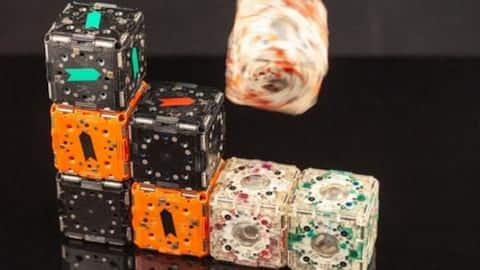MIT's new 'transformer' robots can self-assemble into different structures
What's the story
The idea of a real-world 'transformer' might sound a little crazy, but the fact is, the technology is actually coming to life.
The folks at MIT have developed robot blocks capable of self-assembly; they can identify each other and then move, jump, flip, and spin to assemble into bigger structures and shapes on their own.
Here's all about the smart blocks and their working.
Robots
Meet self-assembling M-Blocks 2.0
Designed at MIT's Computer Science and Artificial Intelligence Laboratory, the modular, self-assembling cubes have been described as 'M-Blocks 2.0'.
They employ a barcode-like pattern on each face to identify, communicate with other blocks and then automatically move and merge with them.
Currently, the blocks can communicate to accomplish simple tasks like clustering together and following a path of arrows or a source of light.
Working
How these robotic blocks work?
Now, in order to form the structures and shapes, the robotic blocks not only move, jump, spin, and flip but also offer the ability to travel along other blocks, climb up or down them.
For this, the machines use an internal flywheel rotating at 20,000 revolutions per minute and built-in magnets that attach seamlessly with other blocks, making up the desired shape.
Goal
This could eventually result in something big
The robotic cubes work incredibly well and the MIT team hopes to develop them into a self-assembling solution for bigger and more capable structures.
Essentially, they hope that larger swarms of freely moving M-Blocks 2.0 could be employed into practical use, like for creating an instant staircase to help first responders rescue a person trapped in a burning building.
Scaling
Scaling this work is also cost effective
The researchers behind the first and the latest rendition of these blocks also say that scaling up from the current point will be easy and cost-effective.
"The unique thing about our approach is that it's inexpensive, robust, and potentially easier to scale to a million modules," John Romanishin, the lead researcher behind these bots, stated. "M-Blocks can move in a general way."
